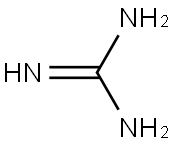Robenidine hydrochloride
- CAS NO.:25875-50-7
- Empirical Formula: C15H14Cl3N5
- Molecular Weight: 370.66
- MDL number: MFCD01724404
- EINECS: 247-307-8
- SAFETY DATA SHEET (SDS)
- Update Date: 2025-12-15 14:23:52

What is Robenidine hydrochloride?
Description
Robenidine hydrochloride (Dexium, Nugatex, Rasexinium, Toraxine) is an antibiotic used as an effective anticoccidial. It does not affect the earliest stages in the coccidial life-cycle and its main activity is against the almost mature first generation schizont. It is used as an aid in the prevention of coccidiosis caused by Eimeria mivati, E. brunetti, E. tenella, E. acervulina, E. maxima and E. necatrix in broiler chickens.
Chemical properties
white or slightly yellow crystalline powder, odorless, slightly bitter taste. Very slightly soluble in ether and water, easily soluble in dilute acid or dilute alkali solution, the color gradually darkens when exposed to light.
The Uses of Robenidine hydrochloride
Robenidine hydrochloride is used as a coccidiostat for use in chickens for fattening and turkeys at a minimum-maximum concentration of 30-36 mg/kg complete feed, and in rabbits for fattening at a minimummaximum concentration of 50-66 mg/kg complete feed withdrawal period of 5 days for all target animals.
Preparation
thiosemicarbazide was formed by addition and rearrangement of sodium thiocyanate with water and hydrazine. Then methylation with dimethyl sulfate and hydrazinolysis to give N.N'-diaminoguanidine sulfate. Then replaced with calcium chloride to N.N'-diaminoguanidine hydrochloride. Finally, it was condensed with p-chlorobenzaldehyde in ethanol again to produce Robenidine hydrochloride with 94% yield.
Antimicrobial activity
Robenidine hydrochloride activity against Eimeria species results from a dual action exerted upon different stages of the parasite as it develops in the intestinal mucosa (Ryley and Wilson, 1971). Initially it acts as a coccidiostat and arrests the development of the first schizont generation. Secondly, robenidine hydrochloride is coccidiocidal, killing the second generation of schizonts and possibly the merozoites. An additional effect against the sexual stage of coccidia development has been observed as well. Robenidine hydrochloride has been shown to be an inhibitor of oxidative phosphorylation (Wong et al., 1972) and is reported to affect the protein metabolism and some other metabolic process of coccidia (Lee and Millard, 1972).
Biological Activity
Robenidine Hydrochloride is an anticoccidial agent mainly for poultry which is also active against MRSA and VRE with MIC50s of 8.1 and 4.7 μM, respectively. IC50 & Target: MIC50: 8.1 μM (MRSA), 4.7 μM (VRE).
In Vitro: Robenidine (compound 1) inhibits the growth of MRSA and VRE with MIC values of 8.1 and 4.7 μM, respectively. Robenidine is bactericidal against all of the S. aureus strains tested with MBC/MIC90 ratios ≤2. A profound and negative impact on the MIC values with a 4-fold decrease with Robenidine at 2% serum and no activity at 50% serum is observed.
In Vivo: The time that the mean plasma concentration exceeds the concentration of 1 μg/mL is approximately 6 h in the Florfenicol (FFC) alone group; however, it is lowered to 4 h by Robenidine (ROB) pretreatment. The terminal elimination half-life (t1/2z), area under the concentration-time curve (AUC), area under the first moment curve (AUMC), and mean residence time (MRT) significantly decreased, whereas the elimination rate constant (λz) and total body clearance (CLz) obviously increased in rabbits pretreated with Robenidine.
Properties of Robenidine hydrochloride
| Melting point: | 252-254°C |
| storage temp. | 0-6°C |
| solubility | Robenidine hydrochloride possesses a weak solubility in water (<1 mg/L), but is soluble in organic solvents: 94 mg/L in dimethylsulfoxide, 46 mg/L in dimethylformamide, 20 mg/L in pyridine and 6.3 mg/L in ethanol (95%). The Log Kow is 3.3 (EFSA, 2004a). |
| form | neat |
| form | Solid |
| color | White to off-white |
| CAS DataBase Reference | 25875-50-7(CAS DataBase Reference) |
Safety information for Robenidine hydrochloride
| Signal word | Warning |
| Pictogram(s) |
 Exclamation Mark Irritant GHS07 |
| GHS Hazard Statements |
H302:Acute toxicity,oral |
| Precautionary Statement Codes |
P264:Wash hands thoroughly after handling. P264:Wash skin thouroughly after handling. P270:Do not eat, drink or smoke when using this product. P301+P312:IF SWALLOWED: call a POISON CENTER or doctor/physician IF you feel unwell. P501:Dispose of contents/container to..… |
Computed Descriptors for Robenidine hydrochloride
New Products
4,4-Difluoropiperidine hydrochloride tert-butyl 9-methoxy-3-azaspiro[5.5]undecane-3-carboxylate Indole Methyl Resin N-Isopropylurea N,N-Dicyclohexylcarbodiimide(DCC) MELDRUMS ACID 5-METHYLISOXAZOLE-4-CARBOXYLIC ACID Magnessium Bis glycinate Zinc ascorbate 1-bromo-2-butyne 2-acetamidophenol 9(10H)-anthracenone Erythrosin B, 4-Piperidinopiperidine 2-((4-morpholinophenylamino) (methylthio) methylene) malononitrile 2,4-dihydroxybenzaldehyde 3-(4-morpholinophenylamino)-5-amino-1H-pyrazole-4-carbonitrile Methyl 2-methylquinoline-6-carboxylate 2,6-dichloro-4-nitropyridine 4-Bromo-2-chlorobenzonitrile 2-(benzylamino)acetic acid hydrochloride 4-(tert-Butoxycarbonylamino)but- 2-ynoic acid 3,4-dihydro-2H-benzo[b][1,4]dioxepine 1-Phenyl-1-cycloprppanecarboxylicacidRelated products of tetrahydrofuran








You may like
-
 25875-50-7 Robenidine hydrochloride 98%View Details
25875-50-7 Robenidine hydrochloride 98%View Details
25875-50-7 -
 Robenidine HCl 97% (HPLC) CAS 25875-50-7View Details
Robenidine HCl 97% (HPLC) CAS 25875-50-7View Details
25875-50-7 -
 Robenidine HCl 98% (HPLC) CAS 25875-50-7View Details
Robenidine HCl 98% (HPLC) CAS 25875-50-7View Details
25875-50-7 -
 Robenidine hydrochloride CAS 25875-50-7View Details
Robenidine hydrochloride CAS 25875-50-7View Details
25875-50-7 -
 3-(4-amino-1-oxoisoindolin-2-yl)-1-methylpiperidine-2,6-dione 98%View Details
3-(4-amino-1-oxoisoindolin-2-yl)-1-methylpiperidine-2,6-dione 98%View Details -
 20677-73-0 (2,2-diethoxyethyl)methylamine 98%View Details
20677-73-0 (2,2-diethoxyethyl)methylamine 98%View Details
20677-73-0 -
 3-(4-(hydroxyamino)-1-oxoisoindolin-2-yl)piperidine-2,6-dione 98%View Details
3-(4-(hydroxyamino)-1-oxoisoindolin-2-yl)piperidine-2,6-dione 98%View Details -
 57381-49-4 2-bromo-4-chlorobenzonitrile 98%View Details
57381-49-4 2-bromo-4-chlorobenzonitrile 98%View Details
57381-49-4
